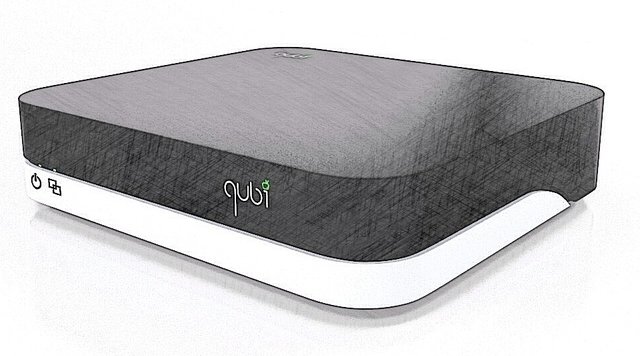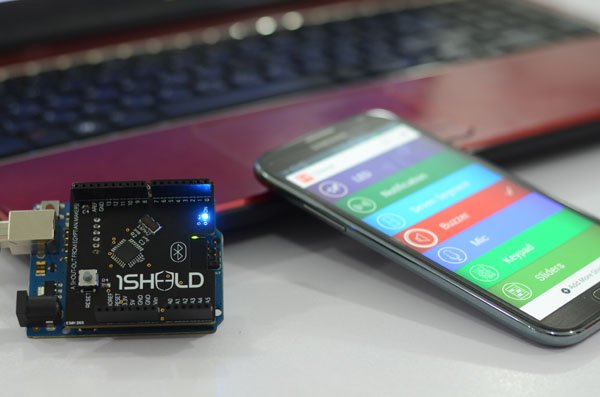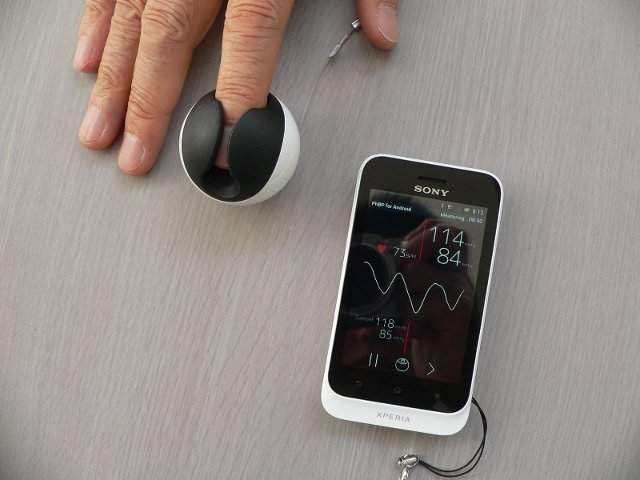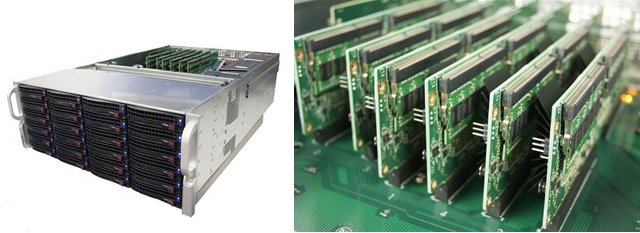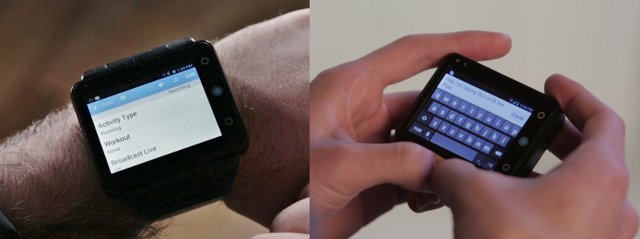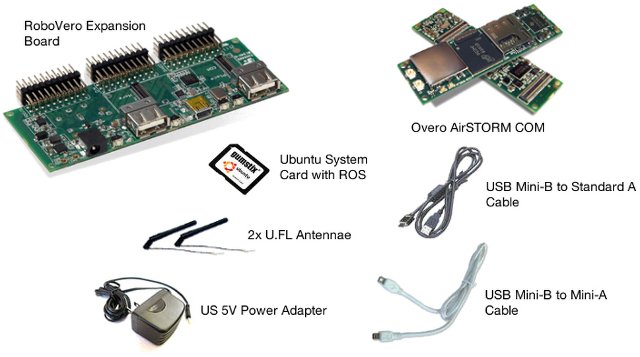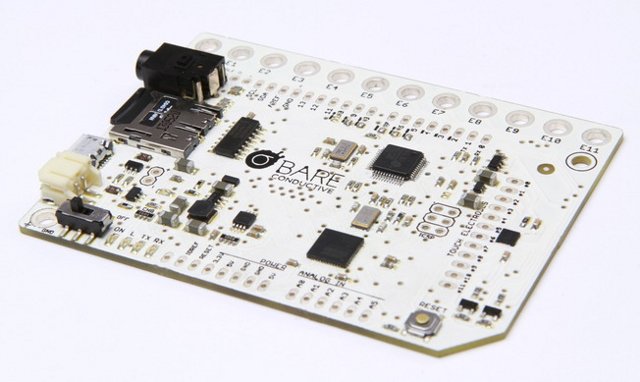Traditionally Qualcomm Application Processor have mostly been found in tablets, smartphones, and in development board such as the company’s own Mobile Development Platforms (MDP) or MyDragonBoard boards. But recently, a Snapdragon S4 has found its way into a smartwatch and today, I’ve found an upcoming, or maybe not, media player powered by Qualcomm Snapdragon 600. Beside Qualcomm quad core Krait SoC, Qubi Android media center features 2 GB RAM, 16 GB NAND Flash, dual band Wi-Fi b/g/n/ac, Gibabit Ethernet, and more. Here are the specifications of the device: SoC – Qualcomm Snapdragon 600 Quad Core Krait CPU @ 1.7 GHz with Adreno 320 GPU System Memory – 2GB RAM Storage – 16GB NAND Flash + microSD slot Connectivity – Dual band Wi-Fi b/g/n/ac, Gigabit Ethernet, and Bluetooth 4.0 Video Output – HDMI with HDMI-CEC support Audio Output – HDMI, optical SPDIF Video – 1080p video decoding USB – 3x USB […]
1Sheeld Arduino Shield Leverages Your Android Smartphone Hardware
To get started with Arduino, a simple board is enough, with soon, you’ll need to add shields for Wi-Fi, sensors, maybe a small display, etc.. and costs add up. Integreight, an Egyptian startup, had to idea to create a simple shield called 1Sheeld that can leverage your smartphone hardware assets such as Wi-Fi, LEDs, sensors, the display, the speaker, etc.., so you don’t have to spend extra money on shields. Technical Specifications: Runs on an ATmega162 @ 16 MHz Uses a standard HC-06 adapter (Bluetooth 2.0) providing up to 30 feet range (about 9 meters) Uses a modified version of the Firmata protocol Can communicate with Arduino using UART 50mA current draw That’s for the hardware, and there’s also a software platform and Android app to manages the communication between the shield and the smartphone, and select different shields options. You’d have to write your sketch using the company’s library, […]
ICMe Cuffless Finger Blood Pressure Monitor Sends Results to your Smartphone via Bluetooth 4.0
Nihon University have developed a tiny blood pressure monitor, which you can just touch with your finger, in order to get maximum and minimum (systolic and diastolic) blood pressures, both average and real-time values, as well as pulse rate and pulse waveform displayed on your smartphone. ICMe uses photo transistors to detect LED light reflected on a finger, and then converts pulse wave data obtained from the light to a blood pressure value. Phase Shift Method-based data processing and algorithm is used for the conversion to a blood pressure value, and results are transmitted to the phone via Bluetooth 4.0 (LE?). The device is composed of a custom main chip, LEDs, photo transistors, and a Bluetooth 4.0 module. Tech-on reports an early much larger model was exhibited last year at Medica 2013, and the new miniaturized model is currently showcased at Medica 2013, which runs from Nov 20 to 23, […]
Boston Viridis 2.0 and AAEON CRS-200S-2R ARM Based Servers Powered by Calxeda Quad core Cortex A15 SoC
Calxeda unveiled its new ECX-2000 Server-on-a-Chip (SoC) at ARM Techcon 2013. Calxeda new chipset features 4 cortex A15 cores, support up to 16GB RAM, and thanks to the move from Cortex A9 to Cortex A15 supports hardware virtualization. I’ve stumbled across two new servers powered by ECX-2000: Boston Viridis 2.0 and AAEON-CRS-200S-2R. Let’s have a look Boston Viridis 2.0 The successor of Boston Viridis powered by Calxeda ECX-1000 quad core Cortex A9 SoC, Viridis 2.0 features six ECX-2000 cards, with each card hosting two four-core SoCs @ 1.8GHz, and consuming as little as 6 watts of power. The server runs Ubuntu 13.10 operating systems, and OpenStack Havana platform, and would typically be used for cloud computing, distributed storage, and virtualization. Viridis 2.0 is a 4U ARM microserver that, and the company claims this can allow up to 1000+ servers in a rack, or about 1.5PB of data storage per rack. […]
Dual Tuner “Simple.TV by SiliconDust” DVR Runs Linux on Zenverge ZN200 SoC
“Simple.TV by SiliconDust” is the full name of a digital video recorder (DVR) featuring two tuners, one input supporting antenna (ASTC) and over-the-air cable (ClearQAM) connections, one Ethernet, and one USB 2.0 host port for external mass storage devices. The device, called HD Homerun on SiliconDust website, is powered by Zenverge ZN200 STB SoC, and runs Linux. This is an upgrade of Simple.TV 1, and it allows you to watch a channel, while recording another, or record 2 programs thanks to the 2 tuners. An app will also be available to watch recorded TV program on Android tablets (coming soon) or iPads, and there’s also an HTML5 client to watch TV in any compatible browser. Recorded shows can be watch from any location with Internet access if you have a Premier subscription. Simple.TV 2 specifications: SoC – Zenverge ZN200 STB SoC with a quad Stream HD Transcoder, audio processing engine, […]
Neptune Pine SmartWatch Phone Powered by Snapdragon S4 Dual Core Processor
More and more companies are jumping on the smartwatch bandwagon. Neptune Computer, a Canadian based startup, has just launched a Kickstarter campaign for the Pine, a watchphone running Android 4.1.2, and featuring a Qualcomm Snapdragon S4 dual core SoC. On the surface it looks very similar to SGPAX S5 smartwatch which also features a dual core processor (Mediatek MT6577), and a SIM card slot, and runs Android 4.0. Neptune Pine, however, comes with features and improvements which may make the 3 to 4 month “kickstarter wait” worth it: a larger 2.4″ detachable screen, larger internal storage, dual camera support, a larger battery providing up to 5 days in standby mode, and an IP67 rating that certifies the device to be dustproof and waterproof at depth of less than 1 meter. Neptune Pine specifications: SoC – Qualcomm Snapdragon S4 Dual-Core Processor @ 1.2Ghz System Memory – 512 MB RAM Storage – […]
Gumstix Announces Solution Kits for their CPU Modules and Boards
Gumstix has recently unveiled several solution kits featuring their Overo and DuoVero Computer-on-Modules (CoMs), Pepper single board computer, and several expansions boards, together with required accessories, and software packages, in order to help their customers getting started more easily. All these solutions are based on Texas Instruments OMAP3, OMAP4, and/or Sitara processors, and run Linux (Ubuntu or Yocto), and sometimes Android for the kits with displays. The solutions kits target 6 different types of applications and/or markets: Robotics Robotic Development Kit (Pictured above) with one Overo AirSTORM CoM (OMAP3703), and RoboVero expansion board. The kit is better suited for motor control applications. Mobile Robotic Development Kit with one Overo AirSTORM CoM, and Turtlecore expansion board to be used with iRobot Create. The kits ship with a Linaro (Ubuntu for Overo) system card and Robot Operating System (ROS) pre-installed. Handhelds 3.5″ Handheld Development Kit featuring Overo AirSTORM CoM with Alto35 cutomizable […]
Almost Anything Can Be A Touch Input with The Touch Board and Electric Paint
Bare Conductive, a British startup, has designed an Arduino Leonardo compatible board with 12 capacitive touch sensors called the Touch Board. You can basically use any conductive material as a touch sensor, but the company’s existing “electric paint” really makes the board come to life, and you can just draw circuit anywhere, be it on paper, your wall, cardboard, and create fun and useful applications. Touch Board specifications: MCU – Atmel ATMega32U4 Microprocessor @ 16 MHz with 32 KB of Flash Memory of which 4 KB is used for bootloader. External storage – MicroSD card slot I/Os: 20 digital I/O pins (3 used for Touch IC and 5 for MP3 IC – can be disabled) 7 PWM channels 12 analog input channels 12 Touch electrodes of which 8 can be configured as extra digital inputs or outputs with PWM capability. (via Freescale MPR121) Audio – Playback and MIDI support via […]


